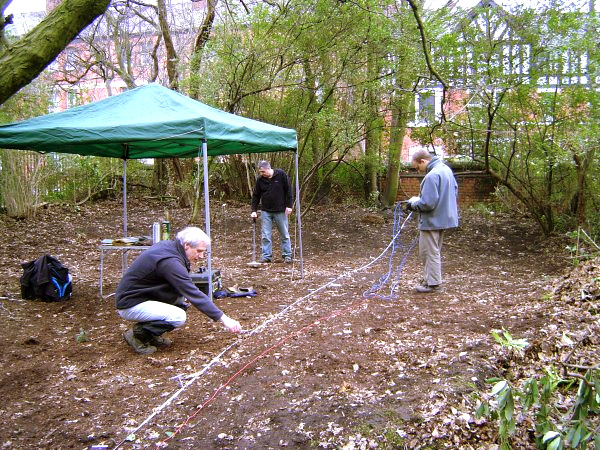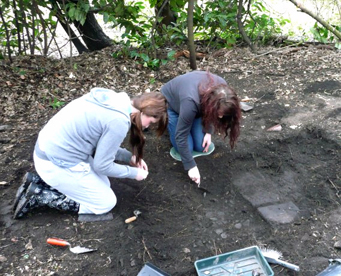
Last month saw our return to the Rectory site where we have been looking for evidence of the original Frog Lane. Last year we located it in an area on the left side of the entrance.
The plan this year is to open up another site on the other side to see if we can locate it there as well. We also hope to find evidence of another entrance to the Hall.
Our first job however was to prepare the site for a visit by the students from Winstanley Sixth Form College, who have shown great interest in our project. Last year's trenches were left open over winter. Fortunately they haven't suffered too much from the ravages of the wet and freezing conditions. One or two areas were irretrievable (such as the deep ditch near the water feature) which we decided to back-fill. However, with a bit of scraping, the main section came up fine, displaying the stratigraphy of the section in good detail.  Our next site - Area 4, lies on the other side of the Hall entrance and our first job here was to establish a datum line from our first site, from which we could mark out our new trenches. Before starting to dig however, we took the opportunity to do a pseudo-section survey.
Our next site - Area 4, lies on the other side of the Hall entrance and our first job here was to establish a datum line from our first site, from which we could mark out our new trenches. Before starting to dig however, we took the opportunity to do a pseudo-section survey.
This resistivity technique gives us the chance to see how deep the archaeology is before digging (the ground is quite high at this point relative to the main road, suggesting a build up of soil). The results, however, showed activity quite near the surface and this was confirmed by selective probing across the site.
On the 1849 map, an alternative entrance to the Hall is indicated, branching off from the old Lane. Our first trench, therefore, was aimed at locating this junction. Nothing emerged in our first 2m x 3m cut, however when we reached the very eastern corner, stonework began to appear just under the surface. By extending the trench by another metre, more and more stonework began to be uncovered until eventually a large section of curbing had been revealed (it was complete with a section of stone guttering and the pebbled surface of the original road). This was quite exciting and with more probing we where able to establish the full extent of the curbing which seemed to cross the whole site.
At this point we decided to mark out a series of trenches for the students to dig during their visit.
The following Monday nine students came down with their tutor, Silvia Marques. Excavations carried on all morning and by early afternoon they had managed to reveal for us curbing and road surface in all our trenches.
This proved that remains of the road survive in all areas of our site. The students were also able to help us with a pseudo-section on the back lawn behind the Hall. I'd like to thank the students for their help and I'm sure they had a great time (some have even showed interest in joining us on our activities at the weekend).
Results from the day will be analysed in the next couple of weeks and displayed on our website. For more information about this project visit our Forum here.
Roman Fort at Wigan
It's official - in the latest publication by the CBA North West entitled Hinterland or 'Indian Country', it has been confirmed for the first time that there probably was a Roman Fort at Wigan in the 1st century AD. The evidence come from excavations carried out here in recent years.
Hillforts of Cheshire
This is the title of this year's Spring Conference by the CBA North West which will be held at Wharton near Winsford in Cheshire. The meeting is on Saturday 7th
May and will include a variety of talks on all aspects of these Iron Age monuments, culminating in a visit to the nearby Hillfort of Eddisbury. If you are interested in attending, contact me at our next meeting.
Next Meeting
Wednesday 6th April in the Concert Room of the Upper Morris Street Working Men's Club (off Greenough Street), starting at 7.30 pm as usual. This month Brian Grimsditch from the Centre for Applied Archaeology at Salford University will be giving us a talk on his favourite site, Buckton Castle. The site lies on a high ridge east of Stalybridge near Manchester and Brian has been excavating there over quite a number of years. The site probably dates to the twelfth century but during the 18th century suffered badly from treasure hunters from rumour of buried treasure there. In the 2nd World War it was used as a anti-aircraft decoy. This site obviously has a long and fascinating history which, I'm sure Brian will enthusiastically bring to
life.
Hope to see you there. - BA
|



